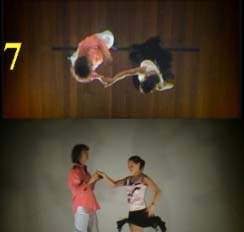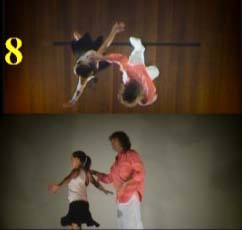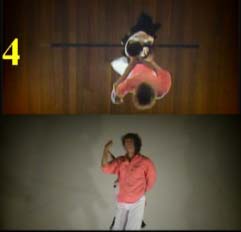
Basic structure of the Salsa MethodThe Salsa Method makes it easy to learn and remember salsa turn patterns in linear styles of salsa by breaking them down into 4 very simple elements. Never again will you watch a cool routine and WISH you could remember it!! All you need to look for are the hand holds, the direction where the dancers are facing in relation to each other, the actions that they perform and the postions they end up in. Sounds complicated? Read on - it is surprisingly simple and soon becomes satisfyingly intuitive! We also introduce a shorthand for recording the figures so you can go back to them whenever you need to. For more about the shorthand click on The Salsa Language. Hand holdsImagine that you are in a salsa class and your instructor starts demonstrating the first turn pattern of the evening. He says: "‘In normal hold the guy leads a right turn…’ etc. This is where the turn pattern starts and remembering the hand hold will help you to lead and remember what comes next. For example, in a crossed hold the leader will be able to lead a reverse but not a normal hammerlock, etc. DirectionsIn salsa styles
danced on the slot, the way the dancers are orientated on the line and
the direction that they are facing is an important part of the dance.
Are the dancers facing each other along the line? Hhas the leader stopped
the follower with her back to him? Or, are the dancers facing the opposite
directions? In the ‘on line’ salsa, the dancers can be positioned
facing along the line of dance or facing perpendicular to the line of
dance. In addition, they can be facing a) each other, b) the same direction
or c) the opposite directions from each other. Here are three examples
that visually demonstrate some of these points.
All possible ‘Directions’ and their detailed descriptions are provided in The Salsa Dictionary. Actions and PositionsSo when do we get to the moves? Because this is the part that we really want to remember! Well, we describe the moves as ‘Actions’ after which the dancers end up in certain ‘Positions’ and The Salsa Dictionary lists and explains many (if not all) possible actions and positions used in salsa with the shorthand to record them for future reference. You don't need to worry about how to get into the position, just remember the position itself. This is because you can achieve the same position via different actions or the same position can be the end point of different actions. Thus, if we remember all possible actions and all possible positions we can put them together while we are learning salsa figures and so crate an infinite number of variations! Information contained in The Salsa Dictionary:
|
| Ordering & Shipping | Information | Translated pages | Contact Us |


